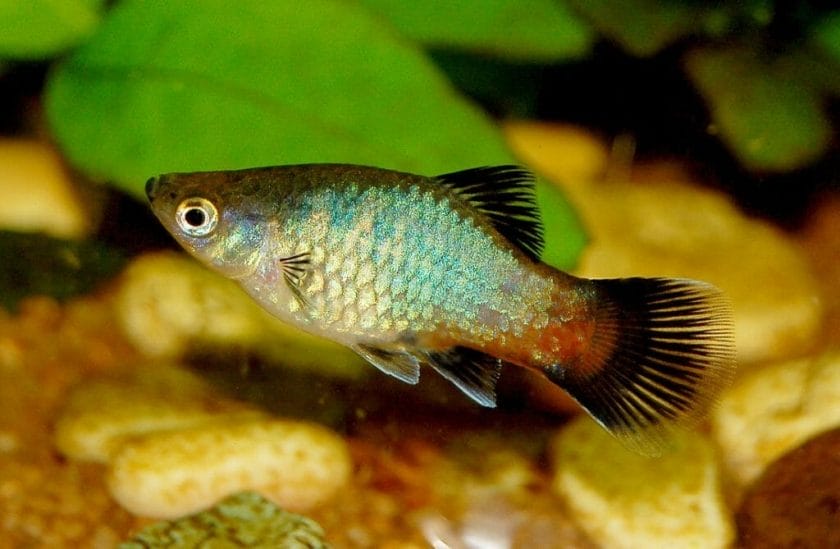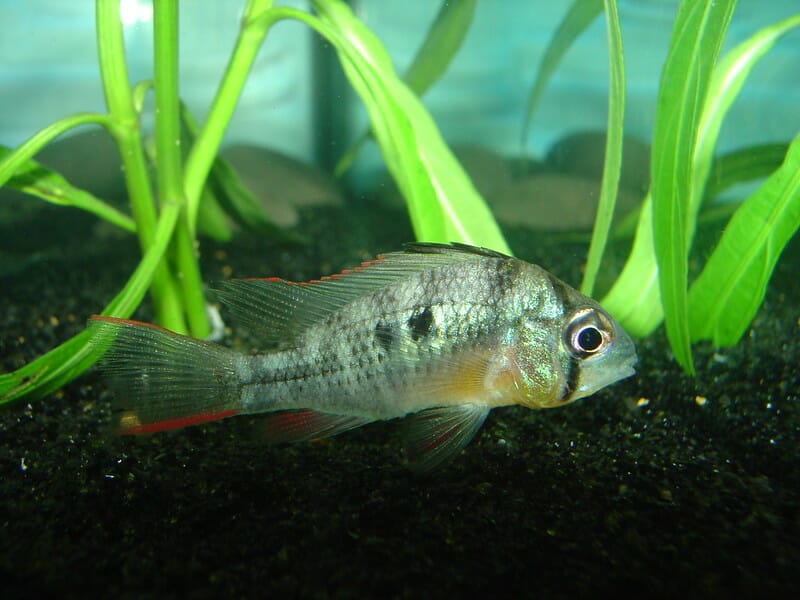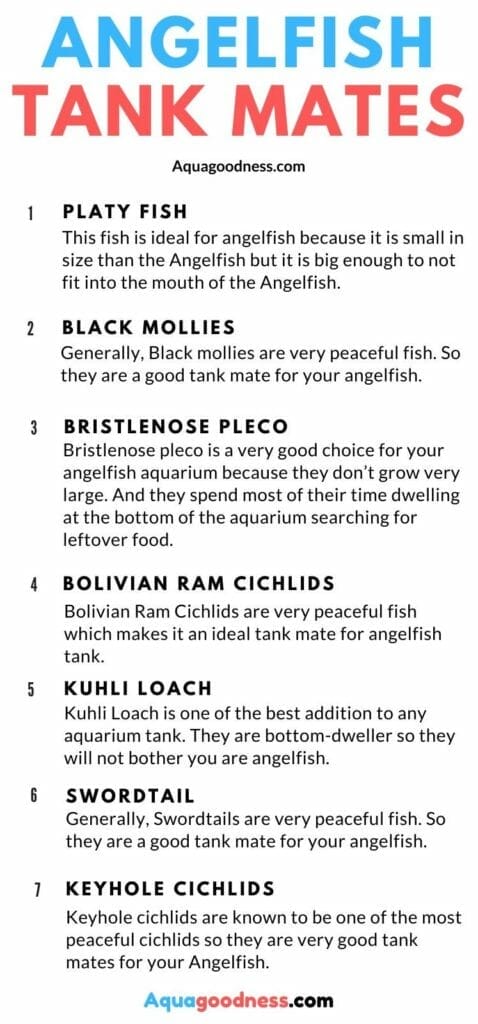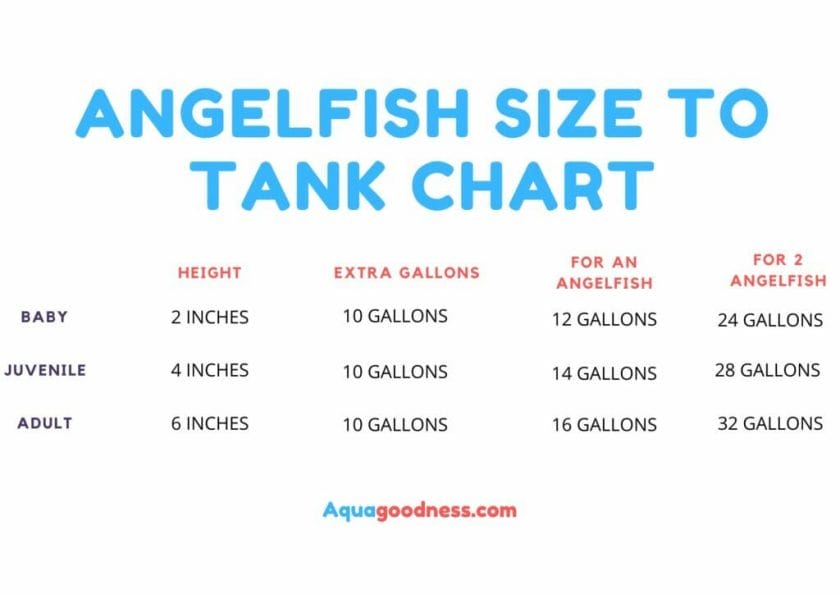The most common question beginners ask when they want to keep angelfish in their tank is what do angelfish like in their tank.
It’s been several years now I have kept angelfish successfully in my aquarium. So based on my experience, I’m going to answer this question in this article.
Angelfish prefer slightly warmer water of about 78 to 84° Fahrenheit.
The pH should be between 6-7.5 and the hardness should be between 5-13° DH.
Angelfish also like tall heavily planted tanks.
And you should keep peaceful fish as tankmates in your angelfish tank.

Table of Contents
Water quality
Angelfish are very susceptible to diseases that’s why maintaining good water quality is very important for successful keeping angelfish in your tank.
Ammonia
Ammonia can be lethal for not only Angelfish but any fish in the aquarium.
To make sure your tank does not contain high ammonia levels you should only put angelfish in a well-established, cycled tank.
Also, you should check the ammonia levels regularly.
If you find found high ammonia levels then you can do these things to lower the ammonia level and get rid of it.
Beneficial bacteria are responsible to keep ammonia levels in control.
So you should make sure that you are tank contain healthy colonies of beneficial bacteria.
And you should preserve the beneficial bacteria.
One of the common places beneficial bacteria forms their colonies is in the biological filter.
While cleaning the filter, you may accidentally remove the beneficial bacteria.
So you should follow the best practices to clean the filter to preserve the beneficial bacteria.
Harmful parasites, bacteria, and viruses
Harmful parasites, bacteria, and viruses can cause disease to your angelfish.
So you should avoid introducing them into your aquarium.
There are a few instances when you may be introducing them into your aquarium accidentally.
The most common way you may be introducing harmful parasites, bacteria or viruses into your tank is while feeding live food to your angelfish.
Live food live bloodworms, brine shrimp are very nutritious and protein-rich.
It is actually a very good diet for angelfish but it also carries the risk of transferring harmful bacteria, virus or parasites into your tank.
So you should only get the live food from a reputed source.
The second most common way people accidentally introduce harmful parasites, bacteria or viruses in their tank is when they add the water of the bag in which they got the fish.
This water may contain harmful contaminants or it can contain a concentrated amount of ammonia especially if the fish is in the bag for a long time.
Another way you may introduce harmful contaminants into the tank is while doing the water change.
So you should always dechlorinate the water that you are going to add to your tank. Check out our recommended Dechlorinating Agent
And make sure that it does not contain any harmful bacteria, viruses, or parasites.
What kind of tank do angelfish need? (Everything you need to know)
Maintain ideal water parameters
Angelfish can tolerate a decent range of water parameters.
But a sudden change in the water parameters like temperature, pH, and hardness can shock the fish.
So you should always try to maintain ideal water parameters within the ideal range.
The ideal temperature range for angelfish is between 78 to 84° Fahrenheit.
Its pH tolerance range is between 6-7.5 and the hardness tolerance range is between 5 to 13° DH.
20 Tips to Maintain a Healthy Aquarium
Oxygen
Fish require oxygen just as we do to survive.
But fish consume oxygen that is dissolved in the water.
So you should make sure that your tank is well oxygenated.
There are a few signs that can tell you that your tank does not contain a healthy amount of Oxygen and your fish is struggling to get the oxygen.
If you notice your fish coming on the surface of the water gasping for air then it is a sign that it is not getting sufficient oxygen.
If you noticed the rapid gills movement of your fish then it suggests that your fish is struggling to get oxygen.
Here are ways to increase oxygen in your tank.
Plants
Angelfish are native to the Amazon River.
And their natural habitat contains a lot of vegetation.
The plants provide them a lot of hiding places that help to reduce the stress.
Angelfish lay their eggs on a vertical surface and they usually lay their eggs on the long leaves of the plant
So plants also provide a good surface to lay their eggs.
Besides, there are a lot of benefits of keeping live plants in the tank.
It helps to oxygenate the tank, lower the temperature and ammonia in the tank, etc.
In captivity, angelfish prefer heavily planted tanks.
So ideally, you should keep a lot of plants in an angelfish tank.
Here are the best Plants you can keep in your angelfish tank.
Ornaments
You should also keep some ornaments like rock and driftwood in your angelfish tank to emulate its natural habitat.
You can also plant live plants on these ornaments.
13 Types of Angelfish for Your Freshwater Aquarium (With Images)
Equipment
Now we are going to see some equipment that you will require for your angelfish tank
Filter
As mentioned earlier, angelfish are very susceptible to diseases that’s why maintaining good water quality is very important.
Filter helps to keep the water in your tank clean and clear.
A filter is also a place where are beneficial bacteria create their colonies that helps to reduce the ammonia in the tank.
So you should use a good filter for your angelfish tank.
Here are some recommendations for canister filters for your angelfish tank.
Light
If you are going to keep your angelfish tank in well-lit areas.
And your aquarium tank does not contain very light-demanding plants then you don’t need light for your aquarium.
But if you are going to keep your tank in a shady area.
Or your tank contains a lot of plants that require a decent light for their proper growth then you should get a good lighting setup for your angelfish tank according to the needs of your plants.
Air pump
If you have good water agitation in your tank.
Or if you don’t see any signs of low oxygen in the tank as I mentioned earlier.
Then it is not necessary to put an air pump in your tank.
But if your tank does not have good water agitation then you should get an air pump for your aquarium.
Besides, the air pump also helps in case your filter stops working.
It will help to keep your tank oxygenated until you fix the issue with the filter.
Check out our recommended Air Pump
Tankmates
There are a few things you should keep in mind while choosing tank mates for your angelfish.
Though angelfish belong to cichlids family which is known for its aggressive behavior, angelfish are relatively peaceful fish.
So you should keep other peaceful fish with your angelfish.
Angelfish have long fins.
So you should avoid keeping fin nipper fish like Tiger barbs in your angelfish tank.
You should also avoid keeping the fish that are very small in size like Neon tetra.
Because Angelfish can eat them easily.
A good rule of thumb to follow is to avoid the fish that are smaller than the size of the mouth of your angelfish.
How Long Do Angelfish Live For?
Best tank mates for angelfish
1. Platy fish

Image by Marrabbio2 under CC BY-SA 3.0
Platy fish is one of the very popular freshwater fish in the hobby.
This fish is very easy to care for and you can keep it in your aquarium even if you are a beginner.
This fish is a good fit as a tankmate for angelfish because it is a very peaceful fish. And it is not too small in size that it can fit into the mouth of your angelfish.
Usually, female platyfish grow longer than the male of the same age.
The female platyfish can get up to 2.5 inches whereas male platyfish can get a maximum of 1.5 inches.
Platy fish is also very easy to breed and they are livebearers.
They also come in different color variants such as salt and pepper, tuxedo, red wagtail.
You can feed them most of the fish food like flakes, frozen or live food.
You should feed them a variety of food to maintain good coloration and health.
2. Black molly

Black Molly by Marrabbio under CC BY-SA 3.0
Black Molly is a very attractive freshwater fish.
This fish is very hardy and can live in almost any water condition which makes it an ideal choice for beginners.
This fish is a good choice to keep as a tankmate in Angelfish tank because it is a very peaceful fish. And it is not very small in size to fit into the mouth of your angelfish.
This fish can eat flakes, frozen or dried food as well as live food.
Besides, Black Molly are livebearers and they are fairly easy to breed.
3. Bristlenose plecos

Image by Pia Helminen under CC BY-SA 3.0
Bristlenose pleco is one of the best fish you can keep in your angelfish tank.
This fish is very peaceful and spends most of its time foraging the substrate for food.
So it will not bother your angelfish.
Besides, Bristlenose pleco is a voracious algae eater so it will help to keep your tank clean and clear.
It is one of the smallest catfish but it is not too small to feet into the mouth of your angelfish.
It can grow 3 to 5 inches long.
As Bristlenose pleco is herbivorous, you can feed it algae wafers as well as treat it with zucchini, romaine, lettuce, and spinach.
You should feed it maximum once or twice a day.
Besides, Bristlenose pleco is relatively easy to breed.
Are Angelfish Freshwater Or Saltwater?
4. Bolivian ram cichlids

Image by NonstickRon under CC BY-SA 2.0
Bolivian ram cichlids is a very peaceful and colorful fish.
This fish is very easy to care for so it is a good choice for beginners.
It features striking colors from yellow to red and silver to blue so it will really stand out in your aquarium.
Bolivian ram cichlid is a bottom feeder fish so it spends most of its time near the bottom of the tank and it will not bother your angelfish.
This fish is not very fussy about food and can eat most of the fish food.
You can feed it flakes or pellets, as well as live or frozen bloodworms, brine shrimp, white worm, etc.
As Bolivian ram cichlids are bottom feeders you should feed them pellets rather than flakes because pellets sink to the bottom more easily than the flakes.
Besides, Bolivian ram cichlids are fairly easy to breed.
5. Kuhli Loach
6. Swordtail
7. Keyhole Cichlids

FAQ
Are angelfish hard to keep?
Angelfish are relatively hardy fish and can tolerate a decent range of water parameters so they are not very difficult to keep in an aquarium.
But angelfish are very susceptible to diseases that’s why maintaining very good water quality is very important for successfully keeping angelfish in your tank.
You should also provide it a variety of food like frozen or dried bloodworms, brine shrimp, flakes and pellets and even vegetables once in a while for its proper growth and development.
Overall, if you maintain good water quality and feed a variety of food to your angelfish then it is not very hard to keep angelfish in a tank.
What size tank do angelfish need?
The ideal tank size for your angelfish really depends on several factors such as:
- Size of the angelfish
- Filtration system you are going to put into your tank
- Plants and other ornaments you are willing to put into the tank
- Tankmates you want to keep with your angelfish.
So a good rule of thumb to follow is to get at least a 29-gallon tank for a pair of angelfish.
It will provide a good swimming space for your angelfish.
It will allow you to keep a lot of plants in the tank.
And with a 29-gallon tank, you don’t have to do water changes very frequently.
Doing water change once a week is sufficient.

Do angelfish like current?
Angelfish don’t like current. They like to float still in the water.
In the wild, Angelfish live in very slow-moving water.
So you should emulate the same and keep the current at very minimum in your tank.
Are angelfish good for beginners?
As mentioned earlier, angelfish are relatively hardy fish and can tolerate a decent range of water parameters.
But as they are susceptible to diseases, you should maintain very good water quality in an angelfish tank.
As angelfish are omnivorous, you should provide it a varied diet for its proper growth.
Besides, I have written a detailed article on this topic here.
What do angelfish eat?
Angelfish are omnivorous. But their diet primarily consists of meaty food. So you should feed them meaty food like live or frozen bloodworms, brine shrimp, etc.
You can also feed them flakes and pellets. As angelfish are omnivorous, you should feed them flakes that contain raw plants, boiled vegetables like zucchini, romaine, spinach, cucumber, peas, etc.
I have written a detailed article on this topic here.
Do angelfish need light?
It is not absence absolutely necessary to have a light in an angelfish tank.
But if you are going to keep your angelfish tank in a shady area then you should add light into your tank to emulate the night and day cycle.
Besides, if you have plants in your tank then you need to have lights in your tank so that plants can prepare their own food.
Do angelfish need live plants?
It is not absolutely necessary to keep live plants in an angelfish tank.
But the natural habitat of angelfish consists of a lot of vegetation. So it is a good idea to emulate the same in your tank and put a lot of live plants in the tank.
Besides, there are a lot of benefits of keeping live plants in the tank such as they help to oxygenate the tank, they help to reduce the ammonia in the tank, etc.
52 Best Freshwater Aquarium Plants For Beginners (And Care Guide)
Should angelfish be kept in pairs?
It is not absolutely necessary to keep angelfish in pairs in a tank.
But keeping at least a pair of angelfish is recommended to promote social interaction.
Why my angelfish being aggressive?
There could be several reasons your angelfish is aggressive.
If you are keeping a lot of female angelfish in a relatively small tank then it is very common that they will get aggressive towards each other.
This happens especially during the breeding period when the female angelfish want to lay their eggs.
So in this case, getting a bigger tank or moving some female angelfish into another tank can help to reduce aggression.
Another reason could be you are not feeding enough food to your angelfish.
If you don’t feed them sufficient food then they will compete with each other.
For juvenile angelfish, you should feed them more times per day, about three to four times per day a little amount of food every time.
For adult angelfish, you should feed them a couple of times per day.
You can feed them flakes and pellets, frozen or dried bloodworms, brine shrimp, and also boiled vegetables.
7 Best Aquarium Plants That Don’t Need Fertilizers
How do you calm angelfish down?
There are a few things you can do to calm down your angelfish if you noticed aggression in them.
If you are keeping angelfish in a smaller tank i.e. less than 30 gallons then it is very common to see aggression among them.
Because they are not getting sufficient space to swim around and form their territory.
So in this case, moving them into a larger time can help to reduce aggression.
If your tank is is empty i.e. it doesn’t have hiding places.
And every time angelfish are on to the face of each other then it is very common to see aggression among them.
So to calm them down, you should introduce plants and ornaments into your tank.
It will provide them hiding places so they will not be stressed out all the time.
15 Things You Must Know Before Buying Your First Aquarium
Why do angelfish chase each other?
There could be several reasons your angelfish are chasing each other.
The common reason is that they are competing with each other.
Angelfish compete with each other if they are not getting sufficient food.
So you should feed them more often in small amounts and see if that works.
Another reason could be you have a lot of female angelfish in a relatively small tank.
Female angelfish compete with each other especially, during the breeding period to lay their eggs.
So moving some angelfish into another tank or upgrading the tank to a larger tank can help to reduce aggression and they will hopefully not chase each other.
Every angelfish has a different personality so they may be chasing each other without any reason.
So in this case, you should introduce some other small tankmates in your angelfish tank so that the Angelfish will not chase each other and instead they will chase other small fish.
While choosing these tankmates, usually, you should choose schooling fish and keep them in at least a group of 6 or more so that the Angelfish will not chase only one fish.
6 Tips to Take Care of Live Plants in Aquarium (For Beginners)
Can angelfish kill each other?
Angelfish belongs to cichlids family which are known for their aggressive behavior.
But angelfish are relatively peaceful fish and they will not directly kill each other.
But angelfish can compete with each other.
So if one angelfish dominates over other angelfish then the other angelfish will stay very small in size and it may die after some time.
Conclusion
So what do Angelfish like in their tank?
Angelfish preference warmer water so you should keep it in the warmer water of about 78 to 84° Fahrenheit.
Angelfish can tolerate a decent range of water parameters but you should maintain the parameters within the ideal range.
The natural habitat of angelfish is consists of a lot of vegetation so you should emulate the same and keep it in a heavily planted tank.
Though Angelfish belong to the cichlids family it is relatively peaceful fish so you should keep other peaceful tank mates with your angelfish.
So these are the things angelfish like in their tank.
I hope you for this article helpful.
If you do, please share it.
As always, happy fish keeping!